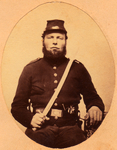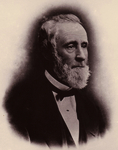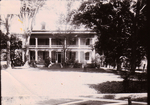On July 5, 1861, the Honorable Edwin D. Morgan, Governor of the State of New York and Commander in Chief of the military and naval forces of the State, issued an order to Col. Charles R. Brundage, commanding the 33rd Regiment, New York State Militia, to rendezvous his regiment at Ogdensburg and prepare it to join the Union Army on the battlefield.
Immediately upon receipt of the above order, Col. Brundage started the task of recruiting men to fill the Regiment. Men came from St. Lawrence County with a few from Potsdam. When the ranks were filled, the Regiment left for Albany on November 1m 1861, and was mustered into the Union Army as the 60th Regiment, New York Volunteers. Historically, the 60th was known as the first St. Lawrence County Regiment. [The 16th Regiment was called the first Northern New York Regiment: the 92nd, the Potsdam Regiment.]
 The 60th Regiment participated in many great battles. When it first reached the South, it was stationed on guard duty protecting the Baltimore and Ohio Railroad, then was sent to Harper's Ferry. Later, it participated in battles of Bull Run (second), Antietam, Chancellorsville, Gettysburg, Lookout Mountain, and Ringgold. At the close of this campaign, while located in Lookout Valley, it was enlisted as a veteran regiment, received a furlough, and returned to Ogdensburg as a regiment.
The 60th Regiment participated in many great battles. When it first reached the South, it was stationed on guard duty protecting the Baltimore and Ohio Railroad, then was sent to Harper's Ferry. Later, it participated in battles of Bull Run (second), Antietam, Chancellorsville, Gettysburg, Lookout Mountain, and Ringgold. At the close of this campaign, while located in Lookout Valley, it was enlisted as a veteran regiment, received a furlough, and returned to Ogdensburg as a regiment.Returning to the Army of the Cumberland before the opening of the campaign of 1864, it participated subsequently in the battles of Resaca, New Hope Church, Peach Tree Creek, and the campaign for Atlanta, where it was the first regiment to raise its flag over the city. It marched with Sherman to the sea, and northward through the Carolinas, and was in the battle of Bentonville.
After the surrender of the Rebel armies under General Lee and General Johnston, the 60th marched with the victorious army to Washington, D.C., and was in the Grand Review of Sherman's Army. Soon after that, it returned to Ogdensburg, where it was mustered out of the service. From first to last, it had a most honorable record.
Edwin A. Merritt
When the staff officers of the 60th Regiment were first elected, while still in Ogdensburg, a young man from Pierrepont, Edwin A. Merritt, was appointed quartermaster. This man became an influential citizen of Potsdam following the War. He was also prominent in national, State and local affairs.
Edwin A. Merritt was bornin in Sudbury, Rutland County, Vermont, on February 26, 1828, one of sixteen children in his family. He lived there until 10 years of age, when he went to live in Westport, Essex County, New York. His early life was one of hardship and deprivation. His grandfather was a Revolutionary soldier, and his great-grandfather was one of the "mminutemen" of Lexington.
In 1841, the family moved to St. Lawrence County, and at the age of 17, Edwin A. Merritt worked on a farm and taught school in the winters. After his farm failed, he began to attend school at the St. Lawrence Academy, there he studied for three fall terms. During the winters until 1852, he taught school in Hannawa Falls.
 Merritt learned surveying at the Academy, and started a career as a surveyor. The outdoor work involved proved beneficial to his health. Until the War broke out in 1861, he followed the business of surveying and making maps of many of the towns in the region. When the railroad was laid from Watertown to Massena, Merritt superintended the laying of the rails from Norwood to Canton, the building of the railway bridge at Canton, and the abutments and piers at Potsdam. In 1859-60, he was elected to the State Assembly by a large majority vote. On November 1, 1861, he received appointment as Quartermaster of the 60th Regiment, N.Y.V., which was in training at Camp Wheeler, Ogdensburg. He left with the Regiment and proved most successful in administering the duties of his office. He conscientiously looked after the welfare of the men of the Regiment, and the soldiers respected and liked him.
Merritt learned surveying at the Academy, and started a career as a surveyor. The outdoor work involved proved beneficial to his health. Until the War broke out in 1861, he followed the business of surveying and making maps of many of the towns in the region. When the railroad was laid from Watertown to Massena, Merritt superintended the laying of the rails from Norwood to Canton, the building of the railway bridge at Canton, and the abutments and piers at Potsdam. In 1859-60, he was elected to the State Assembly by a large majority vote. On November 1, 1861, he received appointment as Quartermaster of the 60th Regiment, N.Y.V., which was in training at Camp Wheeler, Ogdensburg. He left with the Regiment and proved most successful in administering the duties of his office. He conscientiously looked after the welfare of the men of the Regiment, and the soldiers respected and liked him.jaeger-lecoultre replica watches Replica Panerai Luminor 1950 Replica Corum Romvlvs Replica Panerai Luminor Chrono Rolex Datejust Replica
Commissary of Subsistence
On the campaign for Atlanta, Merritt was notified of his promotion to the rank of Captain and to the Commissary of Subsistence, with headquarters in Washington, where he had the job of supplying reinforcements for Sheridan's Army. After this campaign, he was ordered to Annapolis, Maryland, to pay the soldiers commutation of rations under a law which provided for the compensation of prisoners who had been held in rebel prisons. While there, he received notice of his appointment to the staff of Governor Fenton of New York State as Quartermaster General.
These duties, which he formally assumed in January, 1865, included the care of the sick and disabled soldiers who had not only returned from the seat of War, but were also in hospitals convenient to the field of operations.
General Merritt was a close friend of Horace Greeley and William H. Seward, Secretary of State during the War. He knew President Lincoln, and was a member of Governor Fenton's staff appointed to accompany the funeral train through New York State after the President was assassinated. When the 60th Regiment Infantry monument at Gettysburg was dedicated on July 2, 1888, the historical sketch of the Regiment was given by General Merritt.
Following the War, General Merritt was appointed to several positions of trust, and his work was outstanding in every assignment. he was a member of the Constitutional Convention of 1867; he was nominated by President Rutherford B. Hayes in 1877 and confirmed by the Senate first as a naval officer and then as a port surveyor, and in 1879 was named Collector of the Port of New York.
Consul-General to London
The duties of Consul-General to London fell on General Merritt's shoulders in the spring of 1881 when he was appointed to this position by President James A. Garfield. The appointment was confirmed by the Senate, and General Merritt left for his new post on September 3, 1881, accompanied by his wife and by Miss Julia Ettie Crane, who later founded the Institute of Music (now part of the State University of New York, Potsdam College).
Upon their arrival in London, they were greeted by the news that President Garfield, who had been struck down by an assassin's bullet in July, was in critical condition. The President died on September 19, 1881.
Normal School
 General Merritt was also extremely active in local affairs. He was particularly instrumental in locating the Normal School in Potsdam. In 1867, the State of New York passed a law authorizing the establishment of four normal schools. Albany and Oswego had already been selected. Many communities applied for the location of the two other schools, including Ogdensburg and Plattsburgh. Among them was an application from the Board of Trustees of St. Lawrence Academy, Potsdam. The Board offered the Academy property, including lands and buildings. General Merritt presented the application as a member of the Board of the Academy. He was at that time on Governor Fenton's staff. After much difficulty, the Normal School was located in Potsdam, after assurances were received by the location board in Albany that the Potsdam locality would provide $72,000 in addition to the offer of the Academy buildings.
General Merritt was also extremely active in local affairs. He was particularly instrumental in locating the Normal School in Potsdam. In 1867, the State of New York passed a law authorizing the establishment of four normal schools. Albany and Oswego had already been selected. Many communities applied for the location of the two other schools, including Ogdensburg and Plattsburgh. Among them was an application from the Board of Trustees of St. Lawrence Academy, Potsdam. The Board offered the Academy property, including lands and buildings. General Merritt presented the application as a member of the Board of the Academy. He was at that time on Governor Fenton's staff. After much difficulty, the Normal School was located in Potsdam, after assurances were received by the location board in Albany that the Potsdam locality would provide $72,000 in addition to the offer of the Academy buildings. General Merritt was also on the Board of St. Lawrence University in its early times, and served on the Board of Trustees of Clarkson University from its inception until his death, often as president.
General Merritt was also on the Board of St. Lawrence University in its early times, and served on the Board of Trustees of Clarkson University from its inception until his death, often as president. General Merritt and his wife Eliza Rich lived in the house originally built by David Clarkson on Leroy Street. They had four children, three of whom died in infancy. Their son, Edwin A. Merritt, Jr., served in the State Assembly and was a member of the U.S. Congress at the time of his death in 1915. General Merritt, known as the Grand Old Man of St. Lawrence County, died in December, 1916.
General Merritt and his wife Eliza Rich lived in the house originally built by David Clarkson on Leroy Street. They had four children, three of whom died in infancy. Their son, Edwin A. Merritt, Jr., served in the State Assembly and was a member of the U.S. Congress at the time of his death in 1915. General Merritt, known as the Grand Old Man of St. Lawrence County, died in December, 1916.
